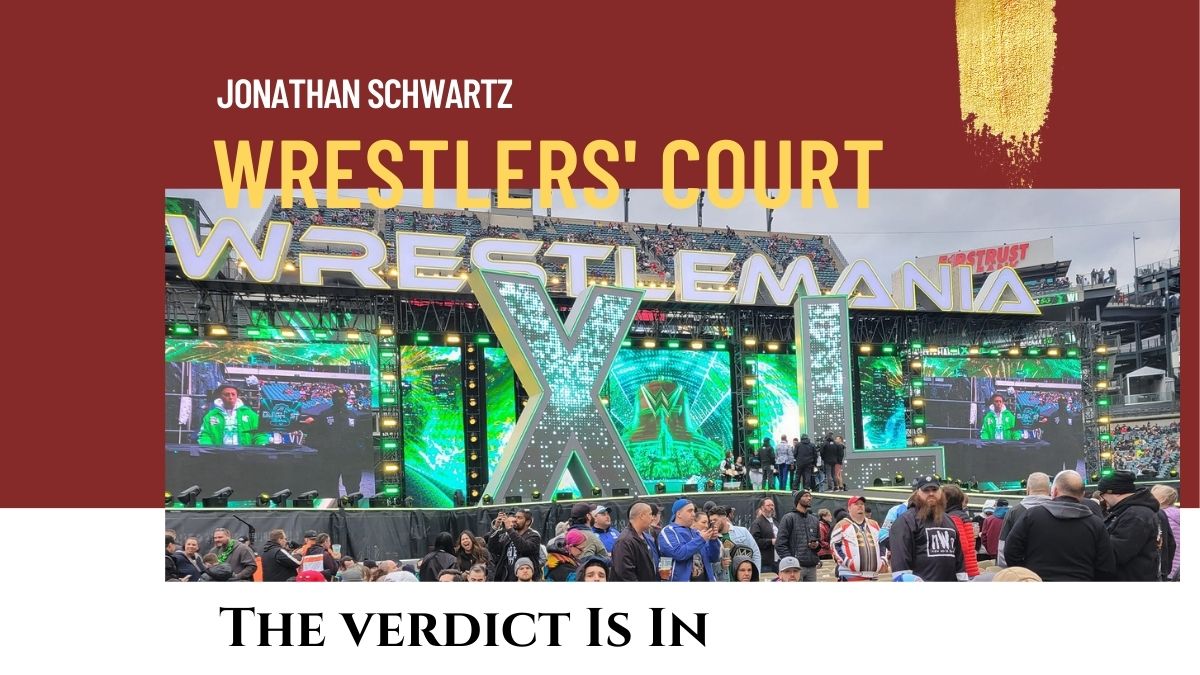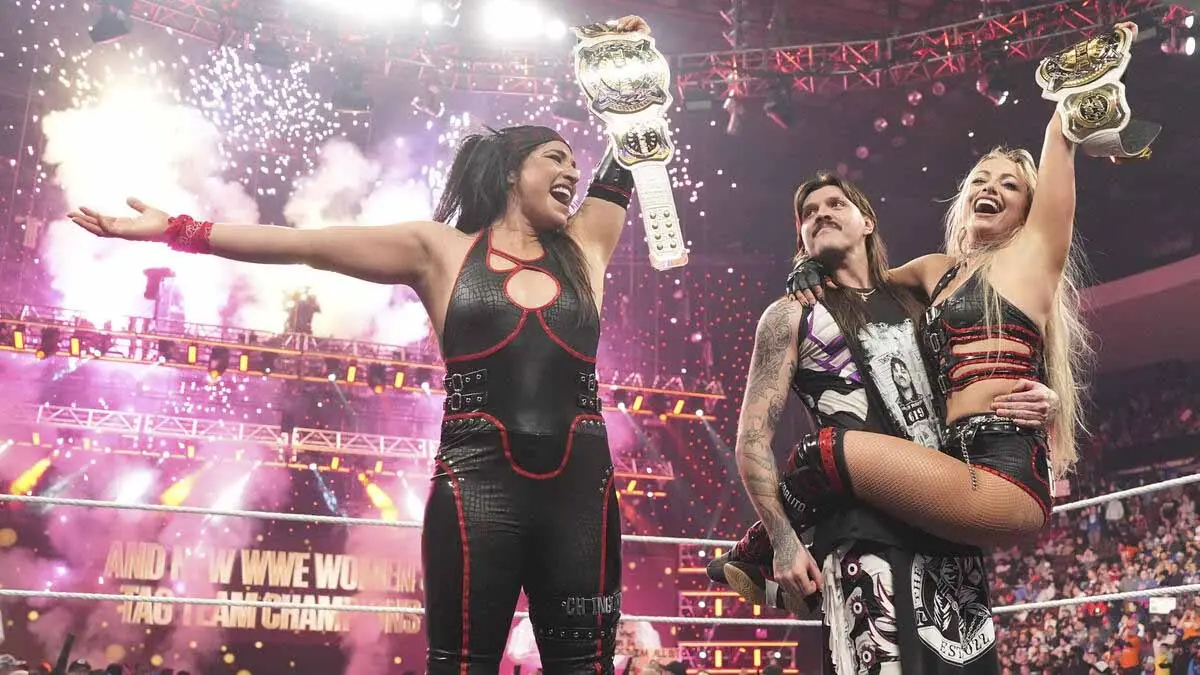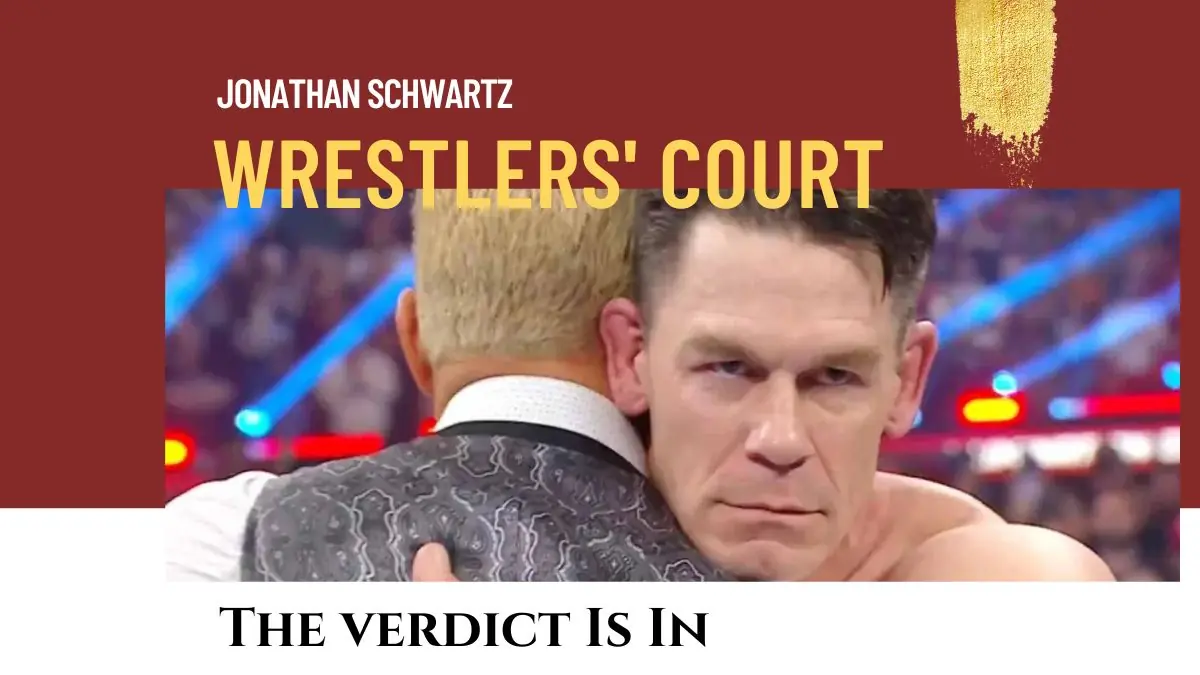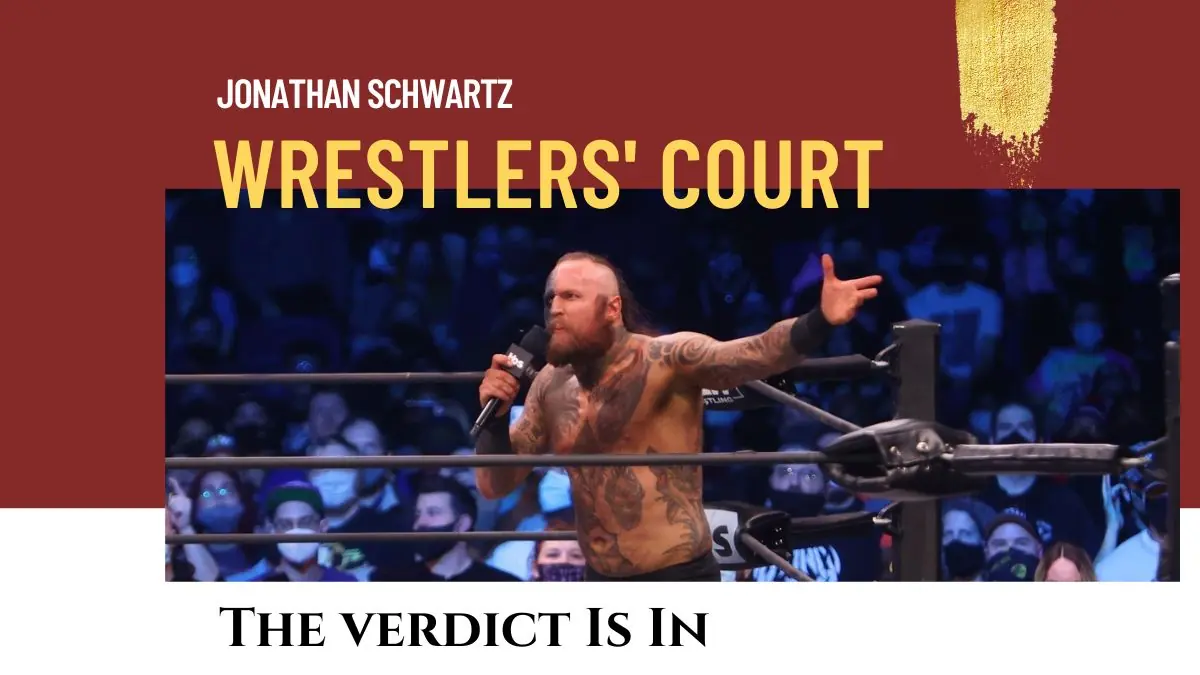I was lucky to watch this year’s WrestleMania at a friends’ house, plus the following Monday Night Raw in the comfort of my own home. I had fun and appreciated the brisk pacing of a show that emphasized in-ring action over extended celebrity cameos (Jason Kelce notwithstanding, and I called that one).
WrestleMania XL had a true ‘big fight’ feel. The video packages before each match took time at the expense of what could have been a few more matches but did a good job of heightening the drama. Each match had time to breathe and furthered a storyline — even late additions like Rey Mysterio and Adrade vs. Dirty Dominik and Santos Escobar, or Lashley and the Street Profits vs. Karrion Kross’ Final Testament were built to draw interest. What could have been a throwaway match between AJ Styles and LA Knight benefitted from a three-month build, including a multi-man main event against Roman Reigns, LA Knight’s field trip to AJ’s house and a pull-apart brawl at a pre-WrestleMania press conference. There were no random Earthquake vs. Adam Bomb or Power and Glory vs. the Legion of Doom squashes, and that is fine by me.
For the most part the announcers stayed at their desks. Even CM Punk remained seated during the opening Night Two contest between Seth Rollins and Drew McIntyre. Punk only got involved after McIntyre’s post-match provocations, which led to Damien Priest cashing his Money in the Bank briefcase and robbing McIntyre of his newly-won championship. I thought this was particularly clever; Punk remains a good guy because he stayed out of the ‘planned’ title match. His takedown of McIntyre may have led to a title change, but you can’t fault him for Priest taking the ultimate opportunity… something Punk would know about as a former Money in the Bank winner. For that matter Priest’s former Judgement Day mentor Adam ‘Edge’ Copeland would know a thing or two about how to use that briefcase. Too bad he’s plying his trade elsewhere now.
Most impressively, we were spared extended stupid skits involving geriatric owners taking clumsy bumps. The Rock may be a ‘geriatric owner’ himself, but he acquitted himself well and, against steep odds, I look forward to his eventual return.
Other writers have covered how WWE’s in-story landscape shifts as a result of Cody Rhodes’, Drew McIntyre’s and Damien Priest’s title wins, along with Bayley beating Iyo Sky and the Awesome Truth (Miz and R-Truth) and A-Town Down Under (Austin Theory and Grayson Waller) finally splitting the Raw and SmackDown tag team championships, so teams have more to fight over.

I’m a bit less interested in the shiny metal belts, although I wonder where we’re headed, which is always a good thing. WWE has always tread the line between predictable and implausible. At the moment they’ve found a sweet spot where I don’t necessarily know what’s coming next, but I’m glad to be along for the ride.
Instead I’m more interested in a word which has been used repeatedly — when it comes to championships and more importantly, to WWE as a whole.
That word is ‘New’.
On Saturday, April 6, WWE Chief Content Officer Paul ‘Triple H’ Levesque performed the traditional WrestleMania welcome speech to open the show; the first version was made 39 years ago by Vince McMahon. At the time it was a bit odd. Budding wrestling fans knew McMahon as a merely competent announcer. Unless you had visibility beyond kayfabe you’d never have known that McMahon owned the then-WWF, and was bidding us Vilkommen, Bienvenu, Welcome to his cabaret of sports entertainment. Today we know more about McMahon than we would ever have wanted. We know so much that McMahon appears to have finally been chased from the successful company that he headed as the result of his own alleged disgraceful conduct. People have been quick to say this year’s WrestleMania feels different. They have argued that everything from booking to character development to pacing to camera angles has changed with Vince no longer at the helm. The usual anonymous sources claim that the vibe backstage has improved since Vince left town. In the meantime Dwayne ‘The Rock’ Johnson continues to buy up WWE parent company TKO’s shares while Vince continues to sell his remaining stake.
And yet, I can’t shake the feeling that as long has he’s living (and maybe after) Vince will never truly be gone from WWE. Vince McMahon was absent from this year’s WrestleMania. His wife, Linda, from whom he has led a separate life for decades, was spotted in attendance. So was daughter Stephanie, who was featured prominently at the pre-Mania Hall of Fame ceremony, and who welcomed the crowd on Night Two and who may be back working with the company. Vince’s apparent departure might be the biggest piece of news, but we’ve been baited and switched before. Not too long ago Vince McMahon ‘retired’ from WWE when his sexual misconduct and corporate malfeasance scandals first broke. He used his control of WWE shares to bully his way back on to the Board of Directors and the executive suite, effectively ousting his own daughter from power. He engineered the sale of WWE to TKO. Then things went to hell and Vince had to resign again. His remaining share in WWE has been diluted considerably. He lacks the direct power to take the company back but WWE is still very much as he left it.

While Levesque may have his own ideas about how to run a pro wrestling company (including bringing back the term ‘pro wrestling’) he has been with the company for almost 30 years, most of them spent working directly with McMahon. Stephanie McMahon’s lifelong connection is obvious. You can see her modelling T-shirt designs in old WWF magazines. In 2000 she was named as the company’s Head Writer. Whether she and Levesque choose to do some things differently, their whole approach to the pro wrestling business is necessarily framed by Vince’s model for success.
Unless the current human trafficking lawsuit reveals further misconduct, Paul and Stephanie are still surrounded by many of Vince’s trusted executives, including Bruce Prichard and Michael Hayes — both of whom have their own baggage, unrelated to the circumstances of Vince’s departure and both of whom are rumored to have been a pipeline between McMahon and WWE during Vince’s ‘retirement’. One can argue that with Vince’s diminished share of the company there is less reason to pay him attention, but McMahon is charismatic and ruthless and it’s hard to see him giving up his influence altogether.
The Rock’s involvement may pose more of an open question. While he has accumulated shares in TKO, he still doesn’t have anywhere near the ownership stake that Vince did. He is a great figurehead as long as he stays out of business and personal trouble otherwise. He is far and away the most successful product of pro wrestling, and has embraced it even as he transcended it in popular culture. I also called his eventual rise to ownership a few years ago when childhood friend Nick Khan rose through WWE’s ranks. The Rock has ties to McMahon as well. Vince sold his failing (second) XFL football league to The Rock, who thought he could make it bigger than the NFL. The Rock is a product of McMahon’s WWF and has maintained a positive business relationship with Vince. He may be another back channel for McMahon’s continued influence along with Khan, who came on board during Vince’s tenure and was seen to leapfrog Stephanie in an executive role.
Vince McMahon’s apparent departure may be the catalyst for all things ‘new’ in WWE, but we will see just how new. So far the new boss looks a lot like the old boss.
In any case Levesque began his speech as follows: “Man, I live for this… Welcome to a new time. Welcome to a New Era. Welcome to WrestleMania.”

Since Levesque opened his mouth, WWE wrestlers, announcers, and hangers-on have made a point of amplifying this ‘New Era’. Stephanie put her own spin on it, calling it the ‘Paul Leveque Era’, which I can understand even if Levesque has smartly downplayed the potential cult of personality surrounding his creative vision. WWE and other wrestling fans get hung up on ‘Great Men and Women’ — the idea that success is attributable to one person even though pro wrestling is inherently collaborative. A great match results from two performers working together, along with the referee who’s in on the plan, timekeepers and commentators and announcers and camera operators and agents and writers and God knows who else backstage.
Levesque pivoted. Smart. At the post-WrestleMania press conference he stated:
It’s not my era, it’s our era. When I say ‘our’ I mean everybody in WWE… The people that endured, the people that hung in there, the people that trusted, the people that – over the last year – gave their sweat and tears to get to where we are…. We wanted to do it and work our a**es off at it and make a product that [fans] could all enjoy… When people are throwing my name at the top of it? It’s their era every bit as much as mine; I can’t do this without all of them.
Even as Levesque announced his New Era he highlighted the people who have been with him forever. Wrestling fans continually crave novelty, but the business is built on recycled ideas. Maybe there are only so many stories to be told. WWE has refashioned itself before. Hulkamania died, ushering in a ‘New Generation’, then the ‘Attitude Era’, the ‘Ruthless Aggression Era’, and what outside observers call the ‘Reality Era’ anchored by Daniel Bryan and CM Punk. Vince tried to convince us that we were entering another New Era only a few years ago, when he bet heavily on babyface Roman Reigns vs. heel Brock Lesnar over several WrestleManias.
What’s interesting here is that the most successful acts from each era are not necessarily the headliners that Vince would have chosen. Hulk Hogan was hand-picked to lead the Rock ’n’ Wrestling revolution. Fans also overwhelmingly supported Wendi Richter and Sgt. Slaughter, both of whom were quickly marginalized when they sought better positions for themselves as the money came rolling in. Maybe Vince learned something: the flag-bearer for the New Generation was supposed to be narcissistic patriot Lex Luger. Fans thought otherwise and we got Bret Hart’s epic championship run. The Attitude Era was born of desperation as the WWF tried to fight off WCW. Steve Austin was a WCW midcarder, destined for the same under Vince’s thumb as the Ringmaster. He first found his anti-establishment voice in ECW and parlayed that into ‘Stone Cold’ fame — a self actualized character. If Vince had his way The Rock would have been an unremarkable good guy with a bad haircut. McMahon did not even want to sign Mick Foley, who helped make half the roster with his deranged character work, first as WWE corporate creation Mankind, then under his own creations — Dude Love and a return to Cactus Jack. Later attempts to manufacture corporate champs like John Cena and Roman Reigns were divisive. Cena succeeded by living his gimmick. I don’t think adult fans ever fell in love with his schtick, but kids did and through perseverance Cena won their parents’ approval (and many of those kids are now young adults, which is frightening). Reigns had to turn heel to be acknowledged by the grownups in the crowd. I guess philosopher Niccolo Machiavelli was right. It is better to be feared than to be loved.
So far the stars of this New Era are awfully familiar. Cody Rhodes won the WWE Universal title in a rematch of last year’s main event — the last WrestleMania under Vince McMahon’s leadership.
The match itself could be seen as a passing of the torch, relying on successive interference by legacy talent including The Rock, John Cena and The Undertaker, plus current star Seth Rollins. But most of these former champions are more Cody’s contemporaries than his predecessors. Cody entered WWE’s developmental system in 2006 and debuted on the main roster a year later, teaming with Hardcore Holly. He has appeared on screen with just about everyone who showed up at Mania.
Rhodes is 38 years old. Damien Priest is in his early 40s. The Miz is too, and R-Truth has a decade on everyone. Even younger champions have had extended runs with WWE. Bayley has been with WWE for 12 years. Becky Lynch for 11. Rhea Ripley is a seven-year veteran of the promotion, and she’s only 27 years old.
One question about the New Era will be whether WWE can address some of the systemic issues that seem to shorten female wrestlers’ careers. Natalya Neidhart is probably the longest tenured woman on the roster. She’s 41 and has been under WWE’s umbrella since 2007. Tamina Snuka made her WWE debut in 2009. She’s 46 years old and has mostly been off TV for years. Both have been used primarily to get other wrestlers over, which is fine. In 2023, WWE released Nic ‘Dolph Ziggler’ Nemeth after 19 years… but there are many more long-term male wrestlers than female.

Vince built the WWF by raiding the old territories of mature, accomplished talent. Early WrestleManias were stacked with proven acts who had gotten over elsewhere. On average, these wrestlers were also deeper into their careers by the point wrestling and the WWF became ‘big time’ and with the old system not quite dead yet, wrestlers had options if they wanted to leave.
Today’s WWE features many wrestlers whose tenure would have been unimaginable back in the day-for many years because there were fewer compelling options, more recently because WWE has taken to developing stars in-house with varying degrees of success.
Talents always drift in and out of the roster. WWE is packed with long-tenured wrestlers. The Undertaker is an outlier with his 27 WrestleMania appearances, and Levesque’s 23 make sense given wrestling’s inclination to keep things in the family. Randy Orton has wrestled at 18 Manias. Kane and Shawn Michaels at 17. Cena at 16. Paul ‘Big Show’ Wight fought 15 times. Copeland, Hart, Chris Jericho and Rey Mysterio have about 14 matches each. Reigns, Seth Rollins, Sheamus, Kofi Kingston and The Miz have more than 10 Mania matches as well — and that doesn’t take into account years where these wrestlers may have been out due to injury or just not booked for the show.

Then again, maybe this job security is part of the New Era. I would be thrilled if, in addition to fresh talent and more mature storytelling we finally see wrestlers being treated better. Unionization of the full roster is likely still a ways off although individual wrestlers have become increasingly savvy about pursuing side acting gigs that give them membership in SAG-AFTRA.
As part of TKO, WWE shares a bed with UFC, whose former owner and current executive head Dana White has been vocally against labor despite mounting criticisms. It’s a blind spot for WWE, which straddles sport and entertainment, both of which have benefitted from strong union presence. Some fans think that Levesque’s status as a former wrestler will help improve working conditions and to a small extent (like giving talent time off over the Christmas holidays) they may be right. More substantive changes will likely still require formal organization. Levesque isn’t unique. During Cody Rhodes’ stint as part of AEW’s executive he was also anti-union. It is hard for wrestlers-turned-bosses to realize that their own success means others wouldn’t benefit from an organized work force… and that they might benefit, too.
I’m as happy as anyone that Cody has finished his championship story. I note that really, he’s just the latest in a series of prodigal champions. I suspect it has to do with NXT’s challenges as a reliable pipeline for main event talent but Rhodes’ narrative, from dissatisfied, under-pushed mid-carder to independent barnstormer to alternate-league champion to glorious, heavily promoted return, has played out repeatedly over the last few years.
The idea that a wrestler must leave a territory in the hopes of coming back to a better spot is almost universal. Foundational WWWF champion Bruno Sammartino first wrestled at Madison Square Garden in 1960. He left, feeling that he was being eclipsed by NWA World champion Buddy Rogers. In his autobiography Sammartino claimed that New York promoter Vincent J. McMahon had him black-balled from the business in response. Sammartino left wrestling entirely until Yukon Eric convinced Bruno to move to Toronto, which had its own thriving Italian population. Sammartino was a huge success in Toronto, which drove demand from other promoters and fueled his return to New York and his record WWWF title reign. Even then, Sammartino’s title win was a snap decision by WWWF management. Faced with a choice between established New York star Argentina Rocca and Sammartino, they went with the 27-year-old Sammartino. Bruno fronted his own New Era. This pattern has repeated itself over time. Pedro Morales, Bob Backlund and Hulk Hogan had short, uneventful WW(W)F runs before being welcomed back as championship liberators.
Swap Rhodes’ ROH-NWA-AEW walkabout for former tag partner Drew McIntyre’s TNA/IMPACT stint, and but for the presence of a live audience at Rhodes’ coronation you have a very similar story. Ditto for Bobby Lashley, who was a former ECW and US Champion in WWE, left to try out mixed martial arts and had his own TNA run, then came back to eventually become champ. Brock Lesnar was a champion before and after he left WWE, but his return to the title picture was big news. Heck, Jinder Mahal pulled off the same trick — although it took The Rock to remind us about it a few months ago,

If this New Era will be defined by anything, I suspect it will be the further erosion of wrestling’s Fourth Wall — the barrier between the violent play that’s presented on TV and in arenas, and the people who act it out — and increasingly the business that provides the stage for the action.
The build to WrestleMania pursued this demolition relentlessly. McIntyre trolled Punk and Rollins online constantly. The Rock beat down Cody Rhodes well after RAW went off the air and leveraged his social media accounts to cut 20-minute promos. WWE has partnered with the A&E Network to air multiple Biography episodes of its superstars (some more rooted in reality than others). WrestleMania weekend was framed by the release of a documentary about the late Windham ‘Bray Wyatt’ Rotunda. WrestleMania ended with Rhodes pinning Reigns — the smile on the latter’s face as he passed the torch was clear for the audience at home to see. Ring announcer Samantha Irvin’s voice shook with emotion as she announced Rhodes’ victory, and he took the microphone and proceeded to address the audience entirely out of character. Rhodes went so far as to call Levesque and Prichard out to the ring with the cameras still rolling.
Maybe this is a necessity post-Vince. Wrestling fans are conditioned to suspend their disbelief. WWE has leaned into this hard over the years. In some cases, they’ve asked more than the audience will bear — calling on fans to treat WWE programming as a retreat from reality even when reality demands to be recognized. Vince’s recent years felt like the end of the Wizard of Oz, where Dorothy and her heartless, brainless, cowardly coterie are directed to “pay no attention to the man behind the curtain.” I still remember Titus O’Neil being trotted out to assuage the audience over McMahon’s retirement — and we all know how that went.
If the New Era means pulling back the curtain and promoting a more transparent, better-run WWE I’m all for it.
TOP PHOTO: Night 1 of WrestleMania XL at Lincoln Financial Field in Philadelphia, PA, on Saturday, April 6, 2024. Photo by George Tahinos, georgetahinos.smugmug.com
RELATED LINK




